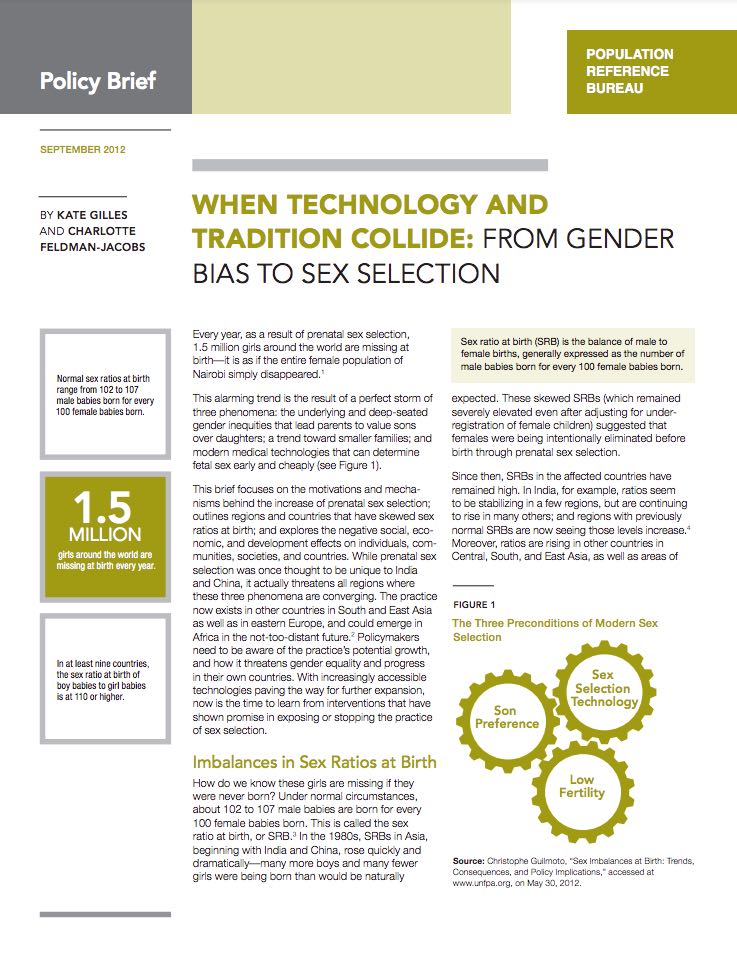
When Technology and Tradition Collide: From Gender Bias to Sex Selection
Other Languages
(October 2012) Every year, as a result of prenatal sex selection, 1.5 million girls around the world are missing at birth—it is as if the entire female population of Nairobi simply disappeared.1
This alarming trend is the result of a perfect storm of three phenomena: the underlying and deep-seated gender inequities that lead parents to value sons over daughters; a trend toward smaller families; and modern medical technologies that can determine fetal sex early and cheaply.
This brief focuses on the motivations and mechanisms behind the increase of prenatal sex selection; outlines regions and countries that have skewed sex ratios at birth; and explores the negative social, economic, and development effects on individuals, communities, societies, and countries. While prenatal sex selection was once thought to be unique to India and China, it actually threatens all regions where these three phenomena are converging. The practice now exists in other countries in South and East Asia as well as in eastern Europe, and could emerge in Africa in the not-too-distant future.2 Policymakers need to be aware of the practice’s potential growth, and how it threatens gender equality and progress in their own countries. With increasingly accessible technologies paving the way for further expansion, now is the time to learn from interventions that have shown promise in exposing or stopping the practice of sex selection.
Imbalances in Sex Ratios at Birth
How do we know these girls are missing if they were never born? Under normal circumstances, about 102 to 107 male babies are born for every 100 female babies born. This is called the sex ratio at birth, or SRB.3 In the 1980s, SRBs in Asia, beginning with India and China, rose quickly and dramatically—many more boys and many fewer girls were being born than would be naturally expected. These skewed SRBs (which remained severely elevated even after adjusting for under-registration of female children) suggested that females were being intentionally eliminated before birth through prenatal sex selection.
Since then, SRBs in the affected countries have remained high. In India, for example, ratios seem to be stabilizing in a few regions, but are continuing to rise in many others; and regions with previously normal SRBs are now seeing those levels increase.4 Moreover, ratios are rising in other countries in Central, South, and East Asia, as well as areas of the Caucasus and Balkans (see table). Only South Korea has managed to achieve a decrease from the elevated levels of the 1980s and now has a normal sex ratio at birth.5
Sex Ratio at Birth in the Most Affected Countries
| Country/Year | Sex Ratio at Birth |
|---|---|
| China (Mainland) (2009) | 118.1 |
| Azerbaijan (2009) | 117.6 |
| Armenia (2008) | 115.8 |
| Georgia (2006) | 111.9 |
| Montenegro (2005-09) | 111.6 |
| Albania (2008) | 111.5 |
| Vietnam (2010) | 111.2 |
| India (2006-08) | 110.6 |
| Pakistan (2007) | 109.9 |
Note: Sex ratio at birth (SRB) is the balance of male to female births, generally expressed as the number of male babies born for every 100 female babies born. The normal biologic range is 102-107 males born for every 100 females.
Source: Christophe Guilmoto, “Sex Imbalances at Birth: Trends, Consequences, and Policy Implications,” accessed at www.unfpa.org, on May 30, 2012.
Kate Gilles is a policy analyst at the Population Reference Bureau. Charlotte Feldman-Jacobs is program director, Gender, at PRB.
References
- World Bank, World Development Report 2012: Gender Equality and Development (Washington, DC: World Bank, 2011).
- World Health Organization, Preventing Gender-biased Sex Selection: An Interagency Statement. OHCHR, UNFPA, UNICEF, UN Women and WHO (Geneva: WHO, 2011), accessed on Jan 19, 2012; and Shantayanan Devarajan, “A Daughter Deficit in Africa?” (August 27, 2009), accessed on Aug. 31, 2012.
- More males are born than females, which compensates for higher rates of mortality among males at all ages. This higher mortality results in decreasing sex ratios among older age groups and a sex ratio in the total population that is usually lower than 100 (there are fewer men than women in the overall population). India calculates sex ratios as the number of girls per 1,000 boys.
- “Seven Brothers: An Aversion to Having Daughters Is Leading to Millions of Missing Girls,” The Economist, April 7, 2011.
- WHO, Preventing Gender-biased Sex Selection; UNFPA, Report of the International Workshop on Skewed Sex Ratios at Birth: Addressing the Issue and the Way Forward (Hanoi: UNFPA, 2011), accessed on Jan. 12, 2012; and Géraldine Duthé et al., “High Level of Sex Ratio at Birth in the Caucasus. A Persistent Phenomenon?” presentation at the Population Association of America Meetings, 2011.

 ">
">